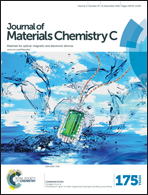Size dependence of optical and mechanical properties of Si3N4 nanobelts controlled by flow rates†
Abstract
Single-crystalline Si3N4 nanobelts (NBs) were successfully synthesized in a size-controlled manner using graphite, nanosilicon and nanosilica powders in N2 gas. The average width of Si3N4 NBs increased with an increase in the flow rate of N2 gas, with 264 nm at 50 ml min−1, 295 nm at 100 ml min−1 and 341 nm at 200 ml min−1. The room-temperature photoluminescence (PL) spectra showed that the synthesized α-Si3N4 nanobelts with three different sizes all had two strong emission peaks located in the yellow and red spectral range, which could be mainly attributed to the incorporation of a small amount of Al in the NBs, and the larger size could also lead to a slight red shift. The Young's modulus of Si3N4 NBs was measured with a hybrid scanning electron microscope/scanning probe microscope (SEM/SPM) system by means of the modulated nanoindentation method. The Young's modulus of Si3N4 NBs strongly depended on their size, decreasing from about 548.6 to 455.1 GPa, which can be explained by surface effects and defect-related effects arising due to their nanometer size. These findings provide a method to tailor the optical and mechanical properties of the NBs in a controlled manner over a wide range of Young's modulus values.


 Please wait while we load your content...
Please wait while we load your content...